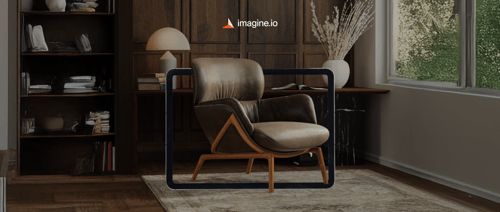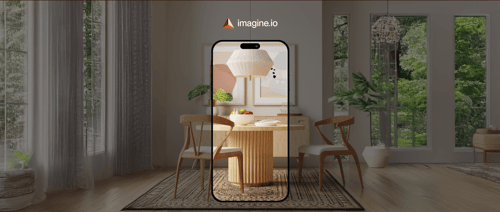Picture a furniture design studio where a designer in Austin refines a chair's curve while a marketing team in Chicago watches the changes materialize instantly on their screens. A supplier in Canada suggests a new wood finish, and within minutes, everyone sees the updated render. This seamless collaboration isn't a pipe dream it's the power of real-time 3D rendering, a technology revolutionizing how furniture brands innovate and deliver in today's fast-paced market.
The Dawn of Collaborative Design
Furniture design is a complex dance of creativity and precision, involving designers, engineers, marketers, and clients. Traditionally, miscommunications and physical prototypes slowed the process, inflating costs and timelines. Now, cloud-based visualization platforms like imagine.io are rewriting the rules. These tools enable teams to work from a single, photorealistic digital model, ensuring that a sleek sofa or a modern dining set aligns perfectly from concept to customer. As one industry executive noted in a market report, the research and visualization quality of such platforms is exceptional, streamlining workflows across the board.
The need for such tools is clear. With teams scattered across cities like New York, Los Angeles, and Dallas, and markets spanning the United States and Canada, real-time rendering eliminates the friction of distance. It delivers instant visual updates, fostering clarity and alignment. Whether it's a designer tweaking a texture or a salesperson pitching to a retailer, everyone sees the same high-fidelity render, making collaboration not just possible but effortless.
Why Real-Time Rendering is Surging
The furniture industry is at a turning point. Online sales are skyrocketing, with eCommerce giants like Ruggable and King Koil leveraging 3D and augmented reality (AR) to let customers visualize products in their homes. According to a Grand View Research report, the adoption of real-time rendering tools is accelerating as brands respond to consumer demand for immersive shopping experiences. This trend is amplified by the shift to hybrid and remote work, where teams need digital workspaces to collaborate effectively.
Speed is critical. Brands face intense pressure to launch products faster while maintaining quality. Imagine.io's cloud-based platform delivers photorealistic assets images, videos, 360-degree views, and interactive configurators in minutes. Unlike competitors who specialize in one area, imagine.io's all-in-one approach sets it apart. Studies show its renders are indistinguishable from professional photoshoots, giving brands the edge to scale across complex catalogs for markets in High Point or Las Vegas.
Transforming Workflows in the Real World
Consider a mid-sized furniture brand struggling to sync its design and production teams. Previously, they relied on costly physical prototypes, shipped between facilities, often leading to delays and misaligned expectations. Now, with imagine.io, they upload a 3D model and generate renders instantly. Designers adjust upholstery, production teams confirm dimensions, and marketers create campaign visuals all from one platform. One brand reported cutting prototype iterations by 60%, saving weeks and significant expenses.
This isn't just about internal efficiency. Sales teams can pitch to retailers like KitchenAid or Hunter Fan with visuals that match the final product precisely. Marketers repurpose these assets for social platforms like Instagram and LinkedIn, where furniture brands engage audiences. Customers, meanwhile, use interactive configurators to customize furniture in real time, boosting engagement and driving sales.
Navigating Barriers to Adoption
Despite its advantages, real-time rendering faces resistance. Legacy CAD systems, entrenched in many workflows, aren't built for real-time collaboration. Some teams hesitate, fearing the learning curve or integration challenges. Others balk at imagine.io's subscription model, which, unlike competitor's project-based pricing, is customized to each client's needs. For brands tied to established agency pools, adopting a new platform can feel risky.
These concerns, however, often dissolve in practice. Imagine.io's no-code interface empowers non-technical users marketers in Chicago or salespeople in Dallas to create and tweak renders without expertise. Its cloud-based system integrates smoothly with existing tools, and the subscription model unlocks unlimited asset creation, ideal for brands scaling across the U.S. or Canada. As noted in a market analysis, the platform's quality and efficiency make it a compelling choice.
Busting the “Too Complex” Myth
A common objection is that 3D rendering is too technical for non-designers. Yet imagine.io's intuitive platform flips this narrative. A marketing lead can adjust a render's lighting as easily as a designer refines a chair's frame, no coding required. This accessibility ensures every team member, from Los Angeles to New York, can contribute to the creative process.
Subscription Value Over One-Off Costs
Custom pricing can seem daunting compared to competitor's flat rates. But imagine.io's model delivers unmatched value: unlimited renders, rapid turnarounds, and fewer physical prototypes. For brands with high-volume catalogs, this scalability translates to significant savings, making the subscription a strategic investment.
Driving Business Success
Real-time rendering delivers measurable wins. Distributed teams collaborate seamlessly, whether in Las Vegas or Canada, reducing miscommunication. Design errors plummet, as production teams work from the same renders as designers. Marketing teams save time by repurposing assets for ads, social posts, or eCommerce configurators, ensuring brands like PepsiCo or Kohler maintain visual consistency across channels.
The customer experience is equally transformative. Interactive 3D configurators let buyers customize furniture choosing fabrics or finishes in real time. Retailers report higher engagement and conversion rates when shoppers can visualize products in their spaces. This isn't just about selling furniture; it's about creating personalized, memorable experiences that drive loyalty.
The Future of Furniture Design
The horizon is bright. AI-assisted rendering, paired with real-time collaboration, promises to eliminate bottlenecks entirely. Imagine a designer uploading a model and AI suggesting optimized textures or configurations instantly. Platforms like imagine.io are paving the way, making advanced visualization accessible to all team members, not just specialists. As cloud-native tools evolve, no-code platforms will empower even small brands to compete with industry leaders.
Industry experts see real-time rendering as the backbone of next-generation design. “Visualization is no longer just a tool it's the foundation of innovation,” says an imagine.io leader. With its blend of speed, scale, and simplicity, the platform is redefining how furniture brands create and connect in a digital-first world.
A Collaborative Future, Rendered in Real Time
Furniture design thrives on collaboration, and real-time rendering is its new catalyst. From streamlining workflows to delighting customers, platforms like imagine.io are transforming how brands bring ideas to life. By cutting costs, boosting efficiency, and enabling immersive buyer experiences, they're setting a new standard. For decision-makers ready to move beyond legacy processes, the path forward is clear: embrace real-time visualization and design the future, together. Explore imagine.io's platform to see how it can redefine your creative process.
Frequently Asked Questions
How does real-time 3D rendering improve furniture design collaboration?
Real-time 3D rendering enables distributed design teams to work from a single, photorealistic digital model that updates instantly across all team member's screens. This eliminates the need for costly physical prototypes and reduces miscommunication between designers, engineers, marketers, and clients working from different locations like Austin, Chicago, or Canada. Teams can now make design adjustments, suggest material changes, and create marketing visuals simultaneously from one cloud-based platform.
What are the main benefits of using cloud-based rendering platforms for furniture brands?
Cloud-based rendering platforms deliver photorealistic furniture assets including images, videos, 360-degree views, and interactive configurators in minutes rather than weeks. Brands report cutting prototype iterations by 60%, saving significant time and expenses while enabling faster product launches. These platforms also allow marketing teams to repurpose high-quality renders across multiple channels like social media, eCommerce sites, and sales presentations, ensuring visual consistency throughout the customer journey.
Can non-technical team members use 3D rendering software for furniture design?
Modern real-time rendering platforms feature intuitive, no-code interfaces that empower non-technical users like marketers and salespeople to create and modify renders without specialized expertise. Marketing leads can adjust lighting and materials as easily as designers refine furniture frames, making advanced visualization accessible to entire teams rather than just technical specialists. This accessibility ensures everyone from Los Angeles to New York can contribute to the creative process without requiring coding skills.
Disclaimer: The above helpful resources content contains personal opinions and experiences. The information provided is for general knowledge and does not constitute professional advice.
You may also be interested in: Why the Future of Product Photography is Virtual: The Rise of 3D Rendering
Struggling with expensive, outdated product visuals that slow down your creative process and stunt eCommerce growth? imagine.io's AI-powered platform empowers furniture, home décor, and textile brands to effortlessly produce striking 3D images, immersive videos, AR experiences, and interactive configurators. Cut production costs up to 70%, boost conversions 5X, speed up prototyping, and supercharge your online sales. Ready to elevate your product visuals and captivate customers? Book a demo with imagine.io today!
Powered by flareAI.co




.png?width=500&name=How%20to%20Add%20a%203D%20Product%20Configurator%20to%20Your%20WordPress%20Website%20(Complete%20B2B%20Guide).png)
















%20(1).png?width=500&name=Why%20Exploded%20Mattress%20Views%20Matter%20(And%20How%20to%20Generate%20Them)%20(1).png)
.png?width=500&name=Best%20Shopify%20Product%20Configurator_%20How%20to%20Choose%20the%20Right%20One%20(2).png)
.png?width=500&name=Why%20Exploded%20Mattress%20Views%20Matter%20(And%20How%20to%20Generate%20Them).png)



.png?width=500&name=Best%20Shopify%20Product%20Configurator_%20How%20to%20Choose%20the%20Right%20One%20(1).png)







.png?width=500&name=How%203D%20Rendering%20Can%20Make%20or%20Break%20Your%20Industrial%20Design%20Pitch%20(1).png)








%20with%20Digital%20Twins%20and%203D%20Visualization.png?width=500&name=Optimizing%20Your%20Digital%20Asset%20Management%20(DAM)%20with%20Digital%20Twins%20and%203D%20Visualization.png)




.png?width=500&name=Styling%20Home%20Decor%20for%202025_%20From%20Global%20Influences%20to%20Playful%20Personalization%20(1).png)
